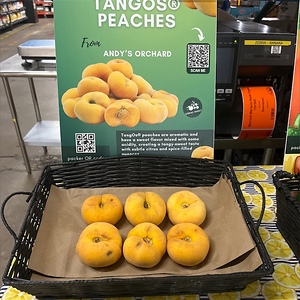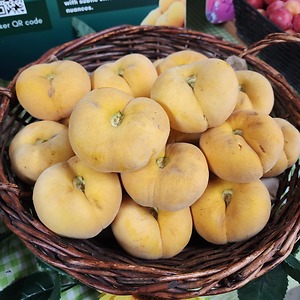


TangOs® Peaches
Estimated Inventory, cs : 0
Description/Taste
TangOs® peaches are a small to medium-sized varietal, averaging 7 to 10 centimeters in diameter and 3 to 4 centimeters in height, and have a flat and longitudinal, oblate shape. The fruit’s skin is thin, smooth, and taut, covered in a light layer of soft, velvety fuzz. TangOs® peaches are known for their unique golden coloring, showcasing pale to bright yellow shades without the red blush commonly associated with yellow peaches. Underneath the surface, the gold flesh is firm, dense, and semi-aqueous with no noticeable fibers creating a pleasant texture. There is also a central clingstone brown pit tightly adhered in the flesh that should be discarded before consumption. TangOs® peaches are aromatic and have a sweet flavor mixed with some acidity, creating a tangy-sweet taste with subtle citrus and spice-filled nuances.
Seasons/Availability
TangOs® peaches are available in the summer.
Current Facts
TangOs® peaches, botanically classified as Prunus persica var. platycarpa, are hybrid fruits belonging to the Rosaceae family. The flat fruits grow on trees that can reach four meters in height, and growers favor the trees for their productive nature. Flat peach varieties are native to China and have been cultivated since ancient times. TangOs® peaches are a modern cultivar developed in the early 21st century in New Jersey and were selected for their solid, pale to bright yellow flesh, disease resistance, and pleasant flavor. The fruits are an early mid-season summer stone fruit commercially sold throughout the United States, utilized as a fresh eating cooking peach. TangOs® peaches were named “Rutgers 250 All-Star Variety” in July of 2016 for their commercial and home garden appeal.
Nutritional Value
TangOs® peaches are a good source of vitamin A to maintain healthy organ functioning and vitamin C to strengthen the immune system while reducing inflammation. The fruits also contain fiber to regulate the digestive tract, potassium to balance fluids within the body, and provide lower amounts of iron, phosphorus, zinc, magnesium, and copper.
Applications
TangOs® peaches have a sweet and tangy flavor well suited for fresh and cooked preparations. The fruit is most commonly consumed straight, out of hand, and the thin skin can be left on or peeled, depending on preference. TangOs® peaches can also be utilized as a fresh topping, sliced into green salads, fruit bowls, yogurt, grain bowls, or ice cream. In addition to raw applications, TangOs® peaches have firm flesh, allowing the fruits to hold their shape well in cooked preparations. The peaches can be cut in half and grilled, sliced and filled with fresh cheeses and herbs, fried as a savory-sweet dessert, or finely chopped and mixed into salsa. TangOs® peaches also have an acidic nature that adds a pleasant depth of flavor to jams, jellies, and sauces and can be incorporated into baked goods, including tarts, cakes, scones, pies, cobblers, and crisps. Beyond culinary dishes, TangOs® peaches can be sliced and stirred into cocktails or used to seasonally flavor specialty beer and wine. TangOs® peaches pair well with meats such as poultry, pork, beef, and fish, honey, citrus, vanilla, chocolate, cinnamon, cloves, and herbs such as mint, basil, and tarragon. Whole, unwashed TangOs® peaches can be ripened at room temperature. Once ripe, the fruits should be immediately consumed for the best quality and flavor, but they will also keep 3 to 5 days in the refrigerator.
Ethnic/Cultural Info
Breeder Joseph Goffreda was recognized as “Inventor of the Year” by the New Jersey Inventors Hall of Fame in 2015. The title was established to honor inventors throughout New Jersey and inspire the next generation to continue the tradition of inventing, leading to careers in science. Goffreda earned this title for his research and creation of TangOs® peaches. The hybrid peach was highly favored by officials for its unusual coloring, firm texture, flat shape, and heirloom flavor. Goffreda also sought to create a peach variety that was easily recognizable by its appearance. Throughout his career, Goffreda has patented eleven other peach varieties, contributing to the growing New Jersey peach industry. Flat peaches were introduced to New Jersey in the 19th century, but the varieties struggled to grow well due to their early blooming nature and lack of tolerance to late frosts. Over time, breeders, including Goffreda, successfully developed new flat peach cultivars with improved frost tolerance, later flowering times, quality flavor, and resistance to common diseases. New Jersey currently ranks fourth in peach production within the United States, following California, South Carolina, and Georgia.
Geography/History
TangOs® peaches were developed by breeder Joseph Goffreda and lab technician Anna Voordeckers at the Rutgers Fruit and Ornamental Research Extension Center in Cream Ridge, New Jersey. The new variety was selectively bred from a parent cultivar labeled A43-143-782081 and was pollinated by a peach known as NJF4, grafted onto lovell rootstock. It took four years before the first tree produced fruit in the early 2000s, and the peaches were initially named NJF16. Goffreda and Voordeckers submitted a patent application in 2006, and the patent was granted in 2008 under PP#18,997. NJF16 was eventually given the marketing name TangOs®, and in 2012, the peaches began appearing in commercial markets across the United States. Today TangOs® peaches are a novel variety sold through farmer’s markets, specialty distributors, and select grocers throughout the United States.
Recipe Ideas
Recipes that include TangOs® Peaches. One
| Spectacularly Delicious |
|
Tango Peach Jam |









